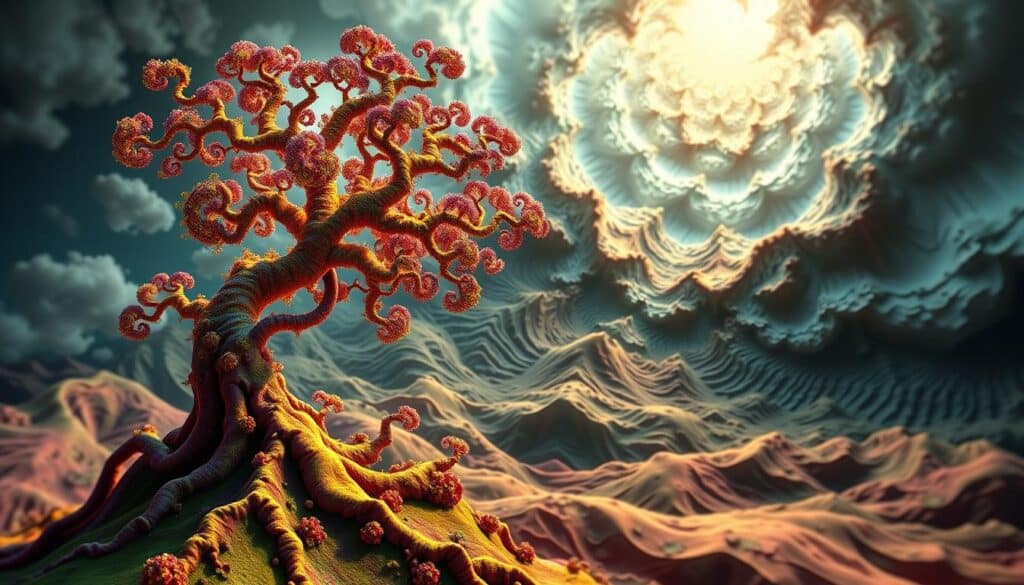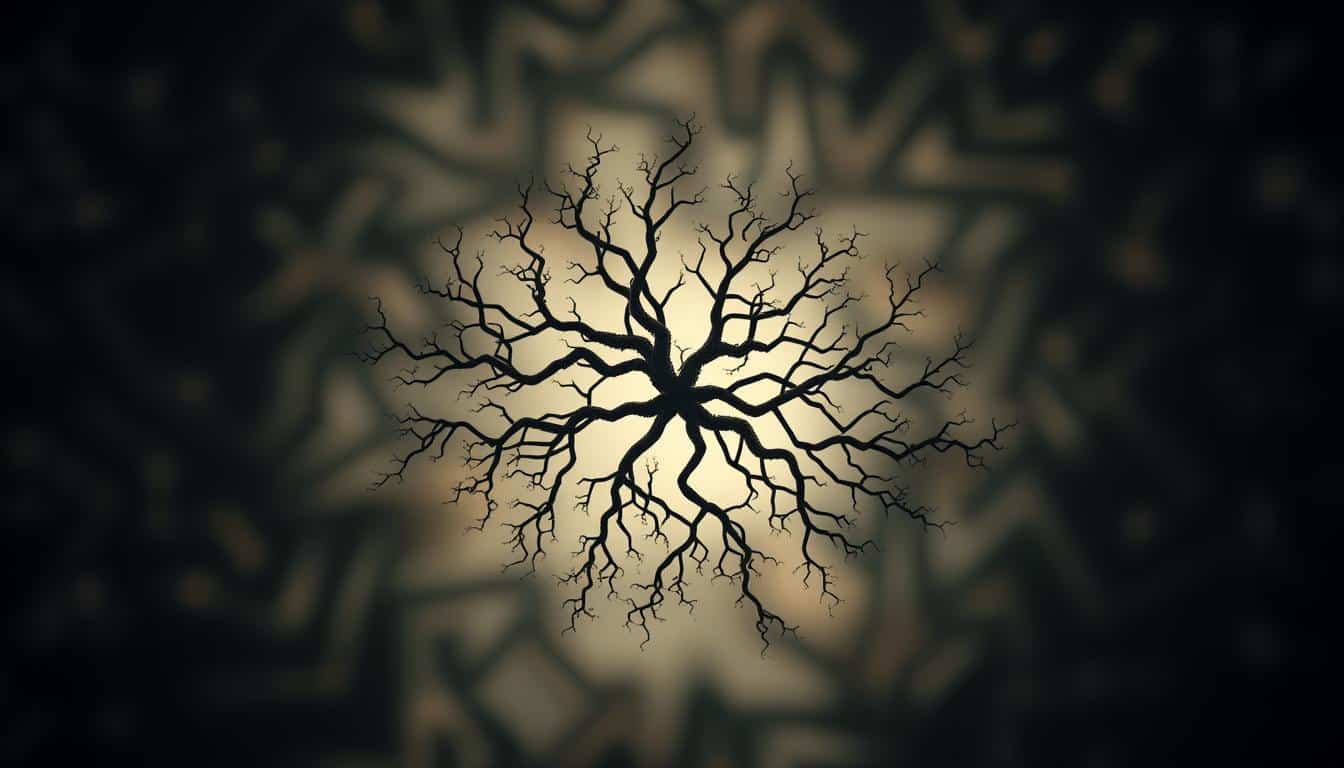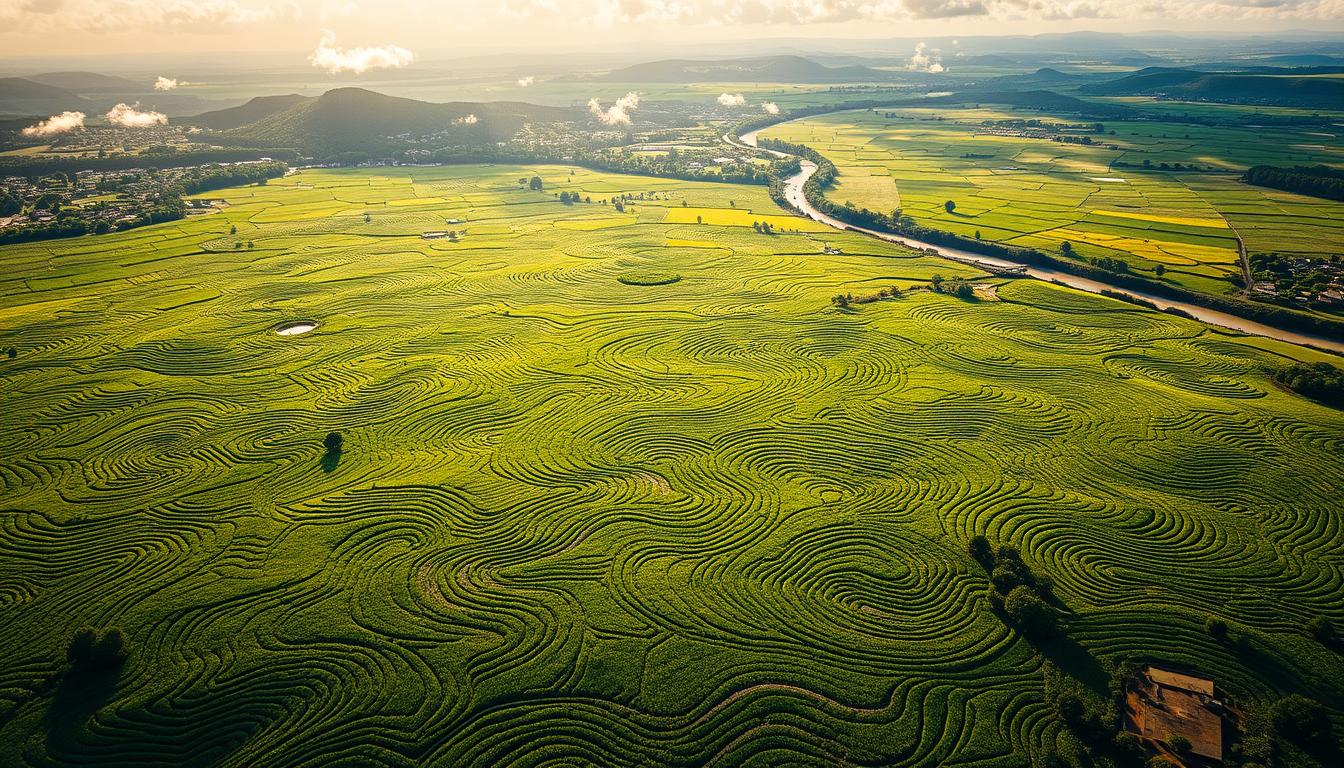Cities worldwide are growing fast, making innovative urban planning essential. This article looks at how fractal patterns can revolutionize sustainable design. These complex designs help create eco-friendly cities that are efficient and community-focused. We’ll dive into how fractals can improve city living and lead to a greener future.
Introduction to Fractal Patterns
Fractal patterns are key in exploring urban systems. They show the complexity of our surroundings. This opens doors to new ways of planning how we use land.
Urban areas are complex systems. Planners face many challenges in development. Fractal geometry helps understand city patterns, aiding in sustainable development.

Fractals guide urban planners to sustainability. They blend natural patterns into city designs. This helps create thriving, eco-friendly environments.
The Concept of Fractals
Fractal theory dives into the intriguing world of repetitive structures across different sizes. It focuses on self-similarity. This means smaller parts of a design look like the entire thing.
This idea helps us better understand nature and city layouts. It lets architects and planners make places both useful and beautiful.
Understanding Self-Similarity
Self-similarity means parts of a pattern look like the whole thing. This is seen in nature and cities. For instance, roads can have self-similar designs, which improves travel and access.
Using this concept brings out new, nature-friendly urban development ideas. It leads to greener and more sustainable cities.
Infinitely Complex Patterns Across Scales
Fractals show us endless complexity. Cities are full of complex patterns that change depending on the size you look at.
Understanding these complexities helps city planners. They can make plans that mirror how a city naturally grows and changes.
By using fractal ideas, planners can build systems that keep up with a community’s needs.
Fractals in Nature and Humanity
Fractals are all around us in nature and our bodies. They help us understand complex designs that work better and save energy. We see these designs in human systems and natural worlds, showing us beauty and efficiency.
Fractals in Human Anatomy and Networks
Our bodies have many examples of fractal geometry, like in our blood vessels and brain connections. Blood vessels branch out following fractal patterns, making sure blood and nutrients flow well. Our brain’s network also follows these patterns, helping our thinking and connecting skills. This makes our body work better and stay healthy.
Examples of Fractals in Natural Systems
Nature teaches us a lot through fractals. We see them in:
- How trees grow, capturing light and resources efficiently.
- River layouts, which help with water flow and moving soil.
- The way coastlines are shaped, affecting ecosystems and where people live.
This knowledge helps city builders create spaces that are both tough and able to change easily.
Fractal Patterns in Urban Planning and Sustainable Design
Fractal patterns are a cool new way to think about building cities. They mix the complex beauty of nature with our city structures. This means our urban areas can look awesome and work well too.
When we use fractal geometry for city planning, we make our cities greener and more alive. It helps us create places where people can walk easily, enjoy greenery, and save energy. Everyone gets to live in a better, healthier place.
Urban planners, listen up: fractal principles are your friend. They help us build cities that get along with nature instead of fighting it. We end up with spaces that are good for the planet and awesome for us to live in.
The Need for Innovative Urban Planning Approaches
Cities today face new challenges traditional methods can’t solve. Old ways often overlook the complexity of city life. This makes it hard for planners to create places that meet everyone’s needs.
Limitations of Conventional Planning Methods
Old planning methods usually follow simple steps and ignore how everything in a city is connected. They fail in several ways:
- They generalize what communities need too much
- They ignore how the environment is changing
- They can’t deal well with surprises
Because of these issues, cities might not grow sustainably for the future.
Role of Complexity Theory in Urban Design
Complexity theory changes how we think about designing cities. It sees cities as networks filled with many interacting parts. With this theory, urban designers can:
- Find solutions that change when cities do
- Get more people involved in planning
- Build cities that last into the future
Using this theory helps planners understand cities better, leading to smarter designs.
Application of Fractal Theory in Urban Pattern Design
The use of fractal theory in urban design is changing how we plan and organize cities. It uses fractal geometry to shape spaces that improve people’s lives. This approach helps make places that reflect natural patterns, making cities better for everyone.
Holistic Solutions for Urban Environments
Fractal patterns in city design lead to better land use. They mix living, working, and play areas well. This means:
- Better movement and access in neighborhoods.
- Less crowding, with more room for nature.
- More socializing in well-planned shared spots.
Fractals and Human Well-Being
Fractal geometry can make a big difference in how people feel. Cities with fractal designs feel more familiar and comfy. Studies show these designs can:
- Lower stress with pleasing, natural shapes.
- Boost mental health with spaces to unwind and have fun.
- Help neighbors bond, making lives happier.
Integrating Fractal Geometry in Urban Development
Using fractal geometry in urban development can make our cities look and function better. Urban planners and architects can use fractal patterns to make cityscapes feel more like the natural world. This method allows for beautiful, eco-friendly designs in our cities.
Fractal geometry helps experts deal with complex urban challenges. They can design streets and buildings that promote togetherness and easy travel. This technique also helps in using the land wisely and protecting the environment, making our cities nicer places to live.
- Promoting biodiversity through environmentally-sensitive designs.
- Creating mixed-use spaces that encourage walkability.
- Utilizing natural ecosystems as models for urban structures.
Adding fractal geometry to our cities does more than change their look. It shows how everything in a city is connected. Moving forward with these ideas can lead to new, eco-friendly city designs. These designs focus on both nature’s wellbeing and our own.
Fractals and Sustainable Urban Infrastructure
Fractal patterns in urban design point to a fresh way to build sustainable cities. These patterns help cities boost their transport systems and the environment. It’s a smart move towards better and greener urban areas.
Optimizing Transportation Networks
Fractals make transport systems work better by fitting traffic flow smoothly. They help reduce jams, connect places easily, and grow with the city. This means cities are ready for today and tomorrow.
- Reduced congestion through natural traffic distribution
- Improved connectivity between various urban areas
- Flexible arrangements that adapt to changing patterns of urban growth
Using fractals lets planners build networks that meet transport needs now and in the future. This approach helps cities stay sustainable.
Enhancing Green Spaces and Environmental Quality
Green areas are key to a city’s health. Fractals help by promoting diverse life and sustainable environments. They also manage water well and provide places for people to enjoy outdoors.
- Creating varied habitats within urban spaces
- Facilitating effective water drainage and retention
- Providing recreational areas that improve overall public health
This way, cities don’t just look good; they are better for living. These green spaces make cities resilient and meet sustainability goals.
Fractal Analysis as a Tool for Urban Resilience
Fractal analysis is a key method to boost urban resilience. It looks at self-similar patterns in cities to reveal how they handle stress. This method helps urban planners see what makes cities vulnerable or strong.
This approach uses sustainability metrics to measure how cities handle crises. Identifying these metrics helps improve urban resilience. Cities can then better face climate change, population increases, and resource shortages.
Fractal analysis helps us understand complex city structures. It guides the creation of strategies for resilience and sustainability. As cities grow, using fractal analysis will be vital for facing future problems.
Future Perspectives: Adopting Fractal Approaches
The future of city planning will see fractal methods being used more. These methods combine knowledge from many fields. Urban studies, sociology, environmental science, and art will all work together. This will make cities stronger and more flexible.
By bringing these fields together, planners can tackle big society problems. They can also make spaces that fit everyone’s needs.
Cross-Disciplinary Applications in Urban Studies
Using cross-disciplinary methods helps make urban areas both useful and beautiful. When different fields work together, new, creative solutions emerge. These solutions take into account how complex city life is.
For example, urban planners can use ideas from nature to create green spaces. These spaces help the environment and make life better for people.
Incorporating Universal Values into Urban Policies
Adding universal values into city policies is key for fairness and including everyone. These values focus on making places easy to get to, sustainable, and fair. They guide how cities are run.
Such policies help build cities that truly represent what everyone wants. They lead to a city environment that brings people together and can change when needed.
Challenges and Limitations of Fractal Approaches in Urban Planning
Using fractal approaches in city planning has its hurdles. Getting detailed and accurate data is tough but vital for success. This makes applying fractal theory to model cities quite challenging.
There’s also the task of fitting these new ideas into old plans. Planners might meet resistance trying to blend modern designs with traditional city layouts. This resistance can come from politics, the economy, and society, making it hard to get everyone on board.
Plus, the complex math in fractal theory can be daunting. Some planners might not be ready for it, slowing down important decisions. As urban areas grow, overcoming these obstacles is key to taking advantage of what fractal theory offers.
Conclusion
The study of fractal patterns in city planning shows how they can help build sustainable communities. These complex patterns help urban planners manage the challenges of city life. They create a balance between beauty and practicality, improving how people live.
Cities are getting bigger and changing fast. It’s important for urban planners to use fractal ideas in their work. This helps them meet the needs of different communities. Fractal designs play a key role in creating green, strong, and beautiful cities.
Fractal patterns are more than just good-looking. They are essential in making cities sustainable. By focusing on these patterns, we can make urban areas that are in sync with nature and the community. This will lead to a better quality of life for everyone.



